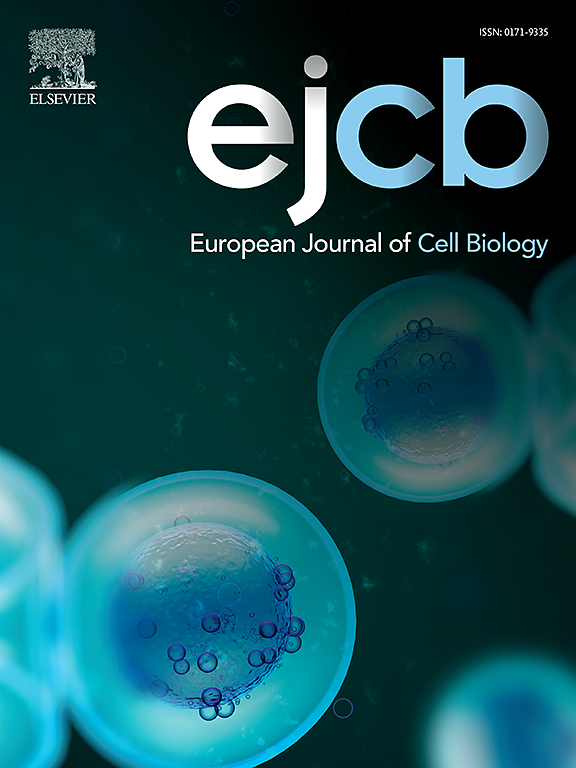遗传补偿强调了神经细胞粘附分子Ncam1在平衡斑马鱼侧线发育过程中的信号通路中的重要性
IF 4.3
3区 生物学
Q2 CELL BIOLOGY
引用次数: 0
摘要
神经细胞粘附分子NCAM1对神经元发育至关重要,并使有组织的细胞迁移、轴突生长和束状形成成为可能。作为斑马鱼基因组复制的结果,出现了类似的Ncam1a和Ncam1b。我们之前发表的使用morpholino敲低实验的发现证明了Ncam1b在斑马鱼侧线系统(一种检测水运动的关键机械感觉器官)发育中的重要作用。Ncam1b突变体表现出严重的缺陷,包括原基迁移受损,前euromast沉积中断,原基内细胞增殖减少。这些缺陷与Ncam1b和Fgfr1a之间的相互作用中断有关,这导致增殖受损和侧线发育异常。然而,目前的研究表明,ncam1b突变体不像突变体那样表现出这种严重的表型。相反,我们观察到细微的变化,包括FGF和Wnt信号的改变以及原基内增殖细胞的重新分配。值得注意的是,ncam1b突变体显示出平行ncam1a mRNA水平升高。ncam1b突变体中ncam1a或upf3a的敲低导致表型类似于ncam1b突变体。Upf3a是遗传补偿的关键调控因子,这是斑马鱼研究中众所周知的现象。这支持了ncam1a上调补偿ncam1b缺失的假设,促进了正常的侧线发育。这些发现强调了Ncam1在斑马鱼侧线发育中的重要作用,并表明ncam1a和ncam1b的保留作为一种保护机制,确保了基因复制后Ncam1关键功能的保存。本文章由计算机程序翻译,如有差异,请以英文原文为准。
Genetic compensation highlights the importance of neural cell adhesion molecule Ncam1 paralogs in balancing signaling pathways during zebrafish lateral line development
The neural cell adhesion molecule NCAM1 is essential for neuronal development and enables organized cell migration, axon growth, and fasciculation. As a result of genome duplication in zebrafish, the paralogs Ncam1a and Ncam1b arose. Our previously published findings using morpholino knockdown experiments demonstrated the essential role of Ncam1b in the development of the zebrafish lateral line system, a mechanosensory organ critical for detecting water movements. ncam1b morphants exhibited severe defects, including impaired primordium migration, disrupted proneuromast deposition, and reduced cell proliferation within the primordium. These defects were linked to a disrupted interaction between Ncam1b and Fgfr1a, which led to compromised proliferation and abnormal lateral line development. The current study reveals that ncam1b mutants, however, unlike morphants, do not show this severe phenotype. Instead, we observed subtle alterations, including altered FGF and Wnt signaling and a redistribution of proliferating cells within the primordium. Notably, ncam1b mutants displayed elevated levels of the paralog ncam1a mRNA. The knockdown of either ncam1a or upf3a in ncam1b mutants resulted in a phenotype resembling that of ncam1b morphants. Upf3a is a key regulator of genetic compensation, a well-known phenomenon in zebrafish research. This supports the hypothesis that upregulated ncam1a compensates for the loss of ncam1b, facilitating normal lateral line development. These findings emphasize the essential role of Ncam1 in zebrafish lateral line development and suggest that the retention of both paralogs, ncam1a and ncam1b, acts as a protective mechanism to ensure the preservation of critical Ncam1 functions after gene duplication.
求助全文
通过发布文献求助,成功后即可免费获取论文全文。
去求助
来源期刊

European journal of cell biology
生物-细胞生物学
CiteScore
7.30
自引率
1.50%
发文量
80
审稿时长
38 days
期刊介绍:
The European Journal of Cell Biology, a journal of experimental cell investigation, publishes reviews, original articles and short communications on the structure, function and macromolecular organization of cells and cell components. Contributions focusing on cellular dynamics, motility and differentiation, particularly if related to cellular biochemistry, molecular biology, immunology, neurobiology, and developmental biology are encouraged. Manuscripts describing significant technical advances are also welcome. In addition, papers dealing with biomedical issues of general interest to cell biologists will be published. Contributions addressing cell biological problems in prokaryotes and plants are also welcome.
 求助内容:
求助内容: 应助结果提醒方式:
应助结果提醒方式:


